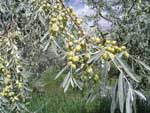Russian Olive
Elaeagnus angustifolia L
Keys to Identification
- Tree or shrub up to 30 ft tall
- Leaf is light green above and silvery beneath
- Many yellowish olive-shaped fruit
This information courtesy of the Colorado Natural Areas Program
Family
Oleaster (Elaeagnaceae)
USDA Code
ELAN
Legal Status
Colorado Noxious Weed List B
Identification
Lifecycle
Perennial
Growth form
Tree, shrub
Flower
Small, light yellow clusters, bisexual.
Seeds/Fruit
Olive-shaped fruits, silver when first formed becoming yellow-red when mature. Produced in 3 to 5 years, in great quantities.
Leaves
Simple, alternate, narrow 2 to 3 in long, and are untoothed. The upper surface of the leaf is light green, the lower surface is silvery white with dense scales.
Stems
To 30 ft tall, trunks and branches have 1 to 2 in long thorns.
Seedling
Can reproduce by seed or root suckers. Tolerant of shade
Impacts
Ecological
Invades both upland and riparian communities. Creates monotypic stands which replaces native vegetation, altering structure nutrient cycling, and system hydrology.
Habitat and Distribution
General requirements
Can grow in a variety of soil and moisture conditions, but prefers open, moist riparian zones.
Distribution
Primarly found in central and western U.S. but is also found in eastern U.S.
Historical
Introduced from Europe.
References
Whitson, T.D.(ed.), L.C. Burrill, S.A. Dewey, D.W. Cudney, B.E. Nelson, R.D. Lee, R. Parker. 5th Edition 1999. Weeds of the West.
Western Society of Weed Science, in cooperation with the Western United States Land Grant Universities Cooperative Extension Services, Newark, CA
Hickman, J.C. (ed.) 1993. The Jepson Manual: Higher Plants of California. University of California Press, Berkeley.


